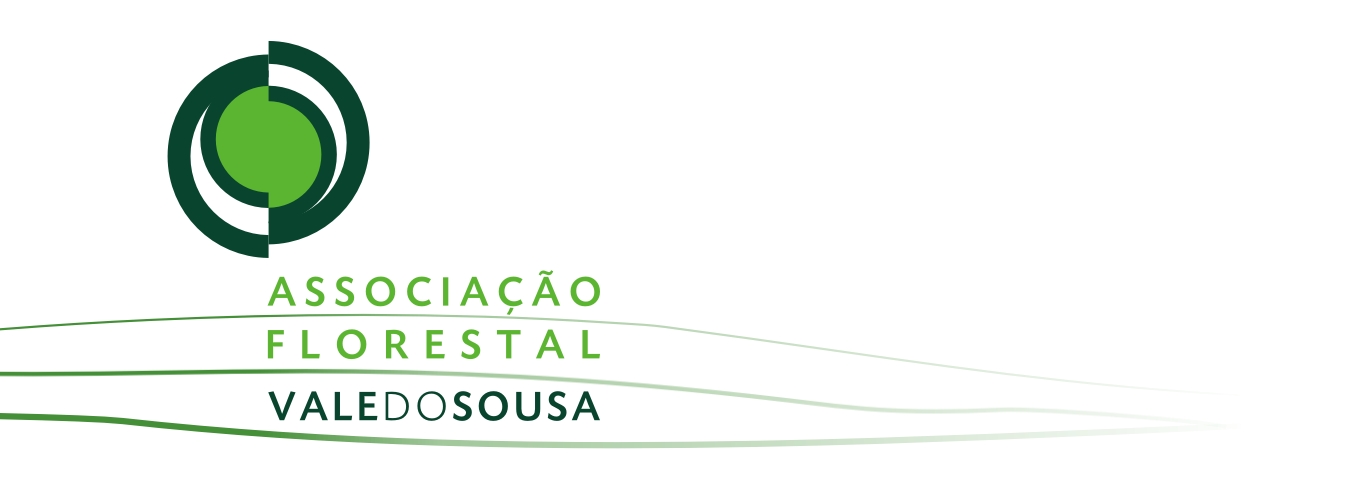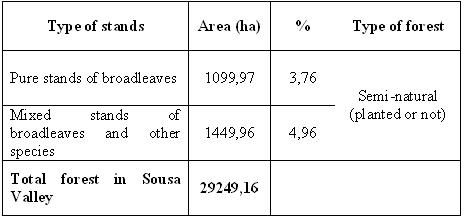Percentage of the total forest covered: 100 %
Costs
TOTAL COST: 27 €
The total cost includes :
1- Data analysis: 27 €
Results
Area of semi-natural forests in Sousa Valley in 2005
Source: NFI 2005
Remarks
Naturalness is the area of forests, undisturbed by man, semi-natural or planted but not under intensive management.
Non disturbed forest is defined as old forests, mainly composed by native species without human intervention during at least 50 years. According to local sources, this type of forests is inexistent in Sousa Valley.
Semi-natural forests are defined as forests that are not under intensive management for a significant period of time. For this type of forest there was data available from NFI 2005.
It was considered that semi – natural forests in Sousa Valley are:
a)Pure stands of broadleaves: these stands include Acacia spp., Fraxinus spp., Quercus sp.;
b)Mixed stands with diverse broadleaves and other species: these stands include Acacia spp., Fraxinus spp., Quercus sp, Pinus pinaster, Eucalyptus globulus, Pinus pinea.
Pure stands of Eucalyptus globulus and Pinus pinaster and mixed stands of Eucalyptus globulus x Pinus pinaster were not considered as semi-natural forests because these stands are forest under intensive management given its production function.
In terms of visual assessment at the plot level it was recorded only 2 plots out of 35 located in stands where Eucalyptus globulus and Pinus pinaster were mixed with other broadleaves. These plots were considered to be “semi-natural”.
Problems and improvements
In Sousa Valley, there are other stands that can be considered semi natural forests. According to foresters working at the local FOA there are some old stands composed by mixed or pure broadleaves with a high conservation value, some of them surrounded by walls (when they are inside aristocratic farms). The characteristics of these stands and their location should be recorded and kept in a database at the local FOA. This organisation is the main entity which carries on frequent contacts with forest owners and provides them technical assistance in the field. The foresters working there know most of those semi-natural stands and are able to identify their characteristics because some of the owners are members of AFVS.
Mixed with the remaining forests inventoried during the National Forest Inventories, these stands of high conservation value can not be distinguished among data. Only the identification and the reference at the local level would report their importance.
Conclusions
Non disturbed forests by man do not exist in Sousa Valley.
Since it is a region with a high population density, almost all the forest is intensively managed and disturbed by man.
Data available to assess semi-natural forests came from the National Forest Inventory (2005). From the field work and through digital cartography available for 1995, it was possible to see that these forests are mainly located along the rivers and streams.
Data about the location and the characteristics of stands with significant conservation value are not available. However, some of these stands are known by the local FOA and at least some information can be checked close to the foresters working there.
These stands should be recorded and forest owners should be supported and encouraged to manage them with the proper forest management.
In abandoned stands, where broadleaves are mixed with Eucalyptus and Maritime pine it would be important to start managing in order improve the quality of these semi-natural forests and to create forests close to the semi-naturalness. Those forests could be important to provide environmental services such as soil and water protection, biodiversity conservation and landscape. This can be considered by the management plans that are going to be prepared for the Zones of Special Intervention.
Naturalness is one of the indicators of Criterion 4 considered by NP 4406 2003. NP 4406 2003 considers that the conservation of relevant natural and semi-natural vegetal communities is important not only as guarantee of the vegetal species that compose them but also as habitat of animal species, some of them endangered.



Initiative Communaitaire FEDER
INTERREG IIIB Espace Atlantique
